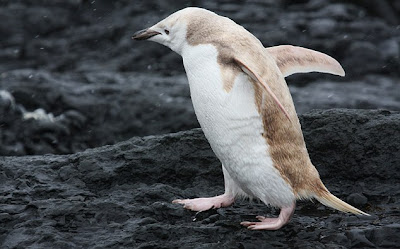 This rare all-white Chinstrap penguin stands out against his friends as he takes his morning waddle around Antarctica
This rare all-white Chinstrap penguin stands out against his friends as he takes his morning waddle around AntarcticaThis rare all-white Chinstrap penguin stands out against his friends as he takes his morning waddle around Antarctica.
The unusual bird was photographed by naturalist David Stephens during a nature expedition to the Aitcho Islands.
Chinstrap penguins' normal black-and-white colouring provides them with camouflage while they dive for fish.

All white: The penguin was spotted during a nature expedition to Antarctica
 Rare: The condition known as leucism only occurs in around 1 in 146,000 penguins
Rare: The condition known as leucism only occurs in around 1 in 146,000 penguinsThe condition which causes the whiteness is known as leucism. It differs from albinism which is a total lack of skin pigment.
Mr Stephen, who works aboard Lindblad Expeditions' National Geographic Explorer ship, wrote in the daily expedition report: 'At the water’s edge stood a leucistic Chinstrap.
'This bird was whitish, but not quite an albino. Instead, it had pigmented eyes and a washed-out version of a Chinstrap’s normal pattern.
'Many wondered about this unusual bird’s chances of success. While odd coloration may make fishing a bit more difficult, leucistic birds are regularly found breeding normally.'

Blending in: Chinstrap penguins' black and white colouring camouflages them when they dive for fish
 The unusual bird was photographed by naturalist David Stephen who works aboard Lindblad Expeditions National Geographic Explorer ship
The unusual bird was photographed by naturalist David Stephen who works aboard Lindblad Expeditions National Geographic Explorer ship Dyan deNapoli, a penguin expert and author of 'The Great Penguin Rescue, said the rate of leucism in Chinstrap penguins is about 1 in 146,000.
He added: 'It is a fairly rare phenomenon. When I was in Antarctica, I never saw one, and I saw a lot of penguins.'
Lindblad Expeditions is a travel company which works in partnership with National Geographic, providing trips to both poles.
Spokeswoman Patty Disken-Cahill said: 'Expedition photography is a big component of our expeditions.
'The photography that comes out of our ships is pretty spectacular.'
source:dailymail












0 comments:
Post a Comment
Note: Only a member of this blog may post a comment.